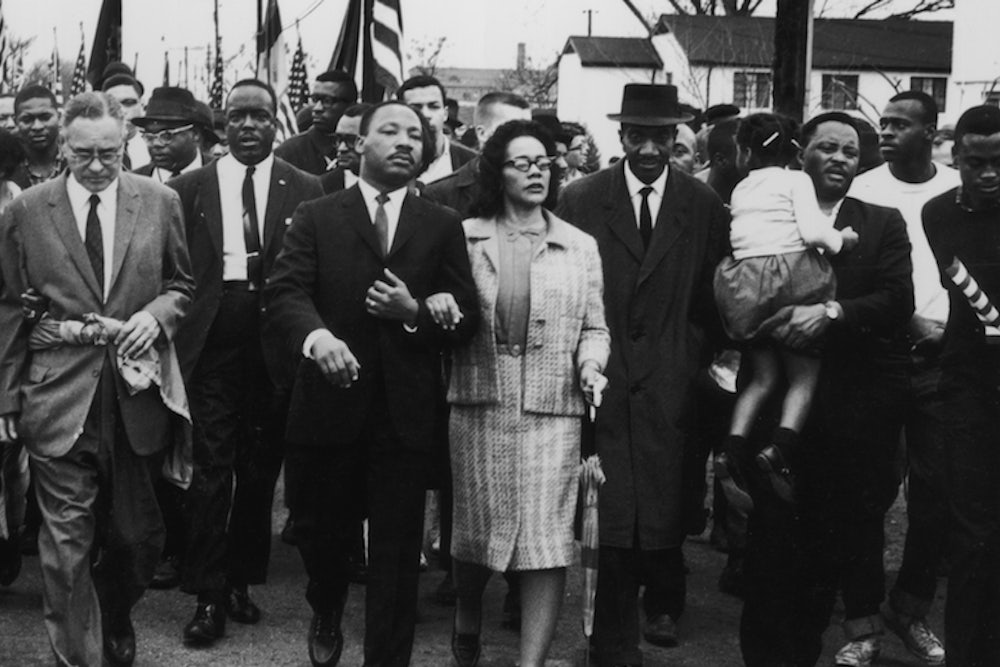There are easier ways to get to Montgomery. The massed power of the army, the national guard, state troopers, and the Justice Department does not lessen the sun’s glare or the force of thunderstorms. The pavement along the 50 miles of the U.S. 80 from Selma is just as hard on the feet, and the muddy campsites just as cold and disagreeable for all the complex battle plans of the marchers and their protectors. By Tuesday, when even the television cameramen began to lose interest, the march had been transformed from a carnival for 3,000 to a crusade for 300. That night, a Presbyterian clergyman—one of the few whites left in the column—leaned against the clay caked tailgate of a farm truck and picked at a cold pork chop. “This,” he smiled, “is our finest hour.”
Whatever the original point of the march—and it has been lost in the events of the last few weeks—the most immediate significance is for the marchers themselves. The young Dallas County Negroes who walk singing freedom songs confirm their commitment to the movement as their fathers and older brothers never did. The thousands of whites who have come to Selma from the North will never, of course, be the same.
When the Selma campaign started two months ago, Brown’s Chapel AME Church was a black citadel; now it is the most thoroughly integrated place in the South. At the Saturday night meeting before the march, there were more white faces than black, and Andy Young, one of the best of Martin Luther King’s organizers, told the outside agitators that they were being taught as much as they were teaching. “You can’t live with us down here without understanding poverty. We could have put you up in fancy motels [they couldn’t] but we wanted you to see how we live. We wanted you to live in Negroes’ homes and see the poverty of our lives. Because before we get out of this movement, we’ll have another one going up North.” For the first time in the lives of most of the whites, a Negro ghetto was their home, and when they walked through it at night they were among friends. If they ventured into the white center of town or the residential areas, they were in enemy territory.
“This is not a spectacle; it’s a pilgrimage,” Andy Young said, but as the marchers flooded over the Petus Bridge Sunday morning, the scene owed more to Cecil B. De Mille than to Saint James of Compostela. It was a kind of instant history, like “You Are There” on the radio, and everyone tried hard to feel it: Two Negro Nobel Peace Prize winners walking hand in hand down an Alabama highway, the majesty of the federal government protecting a ragged band of revolutionaries, the radical change the civil rights movement was effecting in the country.
But it was not until Monday noon, when the column was cut to 300 under the federal court rule, that the march took on more than ceremonial meaning. Just before lunch, the marchers crossed into Lowndes County, the heart of darkness in the Black Belt. Last week, the first Negro since Reconstruction was “processed” as a voter (he was not yet officially registered). Negroes outnumber whites more than three-to-one, but they live in unrelieved squalor and pervasive fear. A few miles into the county, the column passed a ramshackle frame building, which looked like a burned-out barn, but turned out to be the certainly separate but grotesquely unequal Rolan elementary school for Negroes. A small group of students gathered at the side of the road. And Dr. King, Reverend Ralph Abernathy, and Young talked with them. “Do you want freedom?” Young asked a Negro boy on a bicycle. “Yes, sir,” he answered. “Well,” said Young, “in a few years Uncle Sam’s going to send you over to Vietnam or Korea to fight for the white man’s freedom, but you’ve got to start fighting for your own freedom now.” The boys were terrified, and excited. Later that night, one came to the campsite and asked what he could do. He talked with the leader of the students from Selma in a small trailer, found out how to start a protest movement, and then slipped home across a cornfield.
Tuesday it poured, but the songs were louder and the evening camp was, if anything, more full of high spirits. A few Northern whites wondered whether it was all a meaningless gesture; the long fight for the right to march was after all the real victory. At the moment the right was conceded, the march became unnecessary. And on Wednesday, when thousands more joined the 300 where the four-lane highway resumed, and the City of St. Jude Hospital was turned into a kind of civil rights Copacabana, it was again a stagey pageant. But next week, the young Lowndes County boy will ride out on his bicycle to talk to his friends about the movement, and the Negroes of Dallas County—despite the real danger of retaliation—will move into surrounding Black Belt counties, and there is no merchant on Broad Street in Selma who does not know that there will be other walks on other days.
